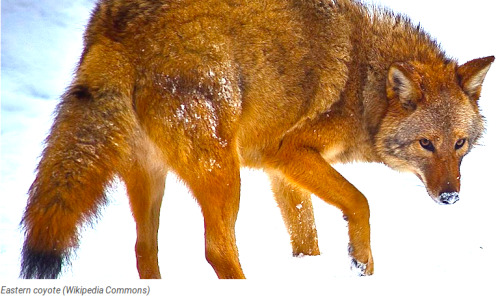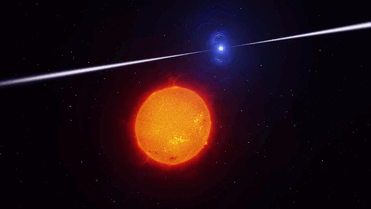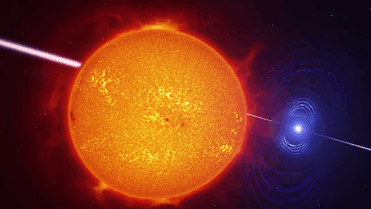Science-is-magical - Science Is Magic

More Posts from Science-is-magical and Others


A new species is evolving before scientists’ eyes in the eastern United States.
Wolves faced with a diminishing number of potential mates are lowering their standards and mating with other, similar species, reported The Economist.
The interbreeding began up to 200 years ago, as European settlers pushed into southern Ontario and cleared the animal’s habitat for farming and killed a large number of the wolves that lived there.
That also allowed coyotes to spread from the prairies, and the white farmers brought dogs into the region.
Over time, wolves began mating with their new, genetically similar neighbors.
The resulting offspring — which has been called the eastern coyote or, to some, the “coywolf” — now number in the millions, according to researchers at North Carolina State University.
Interspecies-bred animals are typically less vigorous than their parents, The Economist reported — if the offspring survive at all.
That’s not the case at all with the wolf-coyote-dog hybrid, which has developed into a sum greater than the whole of its parts.
At about 55 pounds, the hybrid animal is about twice as heavy as a standard coyote, and her large jaws, faster legs and muscular body allow her to take down small deer and even hunt moose in packs, and the animal is skilled at hunting in both open terrain and dense woodland.
An analysis of 437 hybrid animals found that coyote DNA dominates her genetic makeup, with about one-tenth of its DNA from dogs, usually larger dogs such as Doberman pinschers and German shepherds, and a quarter from wolves.
The animal’s cry starts out as a deep-pitched wolf howl that morphs into higher-pitched yipping — like a coyote.
Her dog DNA may carry an additional advantage.
Some scientists think the hybrid animal is able to adapt to city life — which neither coyotes or wolves have managed to do on their own — because her dog ancestry allows her to tolerate people and noise.
The coywolves have spread into some of the nation’s largest cities — including New York, Boston and Washington — using railway corridors.
The interbreeding allows the animal to diversify her diet and eat discarded food, along with rodents and smaller mammals — including cats, which coywolves eat skull and all — and they have evolved to become nocturnal to avoid humans.
The animals are also smart enough to learn to look both ways before crossing roads.
Not all researchers agree the animal is a distinct species, arguing that one species does not interbreed with another — although the hybrid’s existence raises the question of whether wolves and coyotes are distinct species in the first place.
But scientists who have studied the animal say the mixing of genes has been much faster, extensive and transformational than anyone had noticed until fairly recently.
“(This) amazing contemporary evolution story (is) happening right underneath our nose,” said Roland Kays, a researcher at North Carolina State.
Watch this report on coywolves.
Raw Story
The 12 Cranial Nerves and Starbucks

When you walk into Starbucks and you..
I. Smell the coffee aroma (olfactory)..
II. Read the order menu from about 20 feet away (optic) then you..
III. Pupils constrict as you look at items, such as muffins, closer (oculomotor)..
IV. You look up at salesperson then down at your money as you pay (trochlear)..
V. You clench your teeth and touch your face when they called your drink (trigeminal)..
VI. You look side-to-side to see if anyone else has ordered the same drink (abdsucens)..
VII. You smile because you realize this IS your drink (facial), then..
VIII. You hear someone say “You can sit here, we are leaving” (auditory). As you sit..
IX. You taste the sweet whipped cream on the top of your drink (glossopharyngeal)..
X. You say “Ahhhh this is good!” (vagus)..
XI. You look at the person next to you because they heard you and then you shrug your shoulders (spinal accessory)..
XII. When they look away you stick your tongue at them (hypoglossal)!

A Powerful Solar Flare : It was one of the most powerful solar flares in recorded history. Occurring in 2003 and seen across the electromagnetic spectrum, the Sun briefly became over 100 times brighter in X-rays than normal. The day after this tremendous X 17 solar flare – and subsequent Coronal Mass Ejection (CME) – energetic particles emitted from the explosions struck the Earth, creating auroras and affecting satellites. The spacecraft that took these frames – SOHO – was put in a turtle-like safe mode to avoid further damage from this and subsequent solar particle storms. The featured time-lapse movie condenses into 10 seconds events that occurred over 4 hours. The CME, visible around the central sun-shade, appears about three-quarters of the way through the video, while frames toward the very end are progressively noisier as protons from the explosions strike SOHO’s LASCO detector. One this day in 1859, the effects of an even more powerful solar storm caused telegraphs on Earth to spark in what is known as the Carrington Event. Powerful solar storms such as these may create beautiful aurora-filled skies, but they also pose a real danger as they can damage satellites and even power grids across the Earth. via NASA

Babies don’t just look cute, scientists find
What is it about the sight of an infant that makes almost everyone crack a smile? Big eyes, chubby cheeks, and a button nose? An infectious laugh, soft skin, and a captivating smell? While we have long known that babies look cute, Oxford University researchers have found that cuteness is designed to appeal to all our senses.
They explain that all these characteristics contribute to ‘cuteness’ and trigger our caregiving behaviours, which is vital because infants need our constant attention to survive and thrive. The study is published in the journal Trends in Cognitive Sciences.
Morten Kringelbach, who together with Eloise Stark, Catherine Alexander, Professor Marc Bornstein and Professor Alan Stein, led the work in the Department of Psychiatry at the University of Oxford, said: ‘Infants attract us through all our senses, which helps make cuteness one of the most basic and powerful forces shaping our behaviour.’
Reviewing the emerging literature on how cute infants and animals affect the brain, the Oxford University team found that cuteness supports key parental capacities by igniting fast privileged neural activity followed by slower processing in large brain networks also involved in play, empathy, and perhaps even higher-order moral emotions.
The data shows that definitions of cuteness should not be limited just to visual features but include positive infant sounds and smells. From an evolutionary standpoint, cuteness is a very potent protective mechanism that ensures survival for otherwise completely dependent infants.
Professor Kringelbach said: ‘This is the first evidence of its kind to show that cuteness helps infants to survive by eliciting caregiving, which cannot be reduced to simple, instinctual behaviours. Instead, caregiving involves a complex choreography of slow, careful, deliberate, and long-lasting prosocial behaviours, which ignite fundamental brain pleasure systems that are also engaged when eating food or listening to music, and always involve pleasant experiences.’
The study shows that cuteness affects both men and women, even those without children.
‘This might be a fundamental response present in everyone, regardless of parental status or gender, and we are currently conducting the first long-term study of what happens to brain responses when we become parents.’ said Kringelbach.

A dash of graphene can transform the stretchy goo known as Silly Putty into a pressure sensor able to monitor a human pulse or even track the dainty steps of a small spider1.
The material, dubbed G-putty, could be developed into a device that continuously monitors blood pressure, its inventors hope. It also demonstrates a form of self-repair that may herald smarter graphene composites.
Since graphene was first isolated in 2004, researchers have added these atom-thin sheets of carbon to a panoply of different materials, hoping to create composites that benefit from its superlative strength and electrical conductivity. But there have been surprisingly few attempts to blend it with ‘viscoelastic’ materials such as Silly Putty, which behaves as both an elastic solid and a liquid. Leave a lump on top of a hole, for example, and it will slowly ooze through.
Conor Boland, a researcher working in Jonathan Coleman’s nanotechnology lab at Trinity College Dublin, wondered what would happen if he brought the two materials together. “I’d like to be able to say it was carefully planned, but it wasn’t,” laughs Coleman. “We’ve just got a tradition in my group of using household stuff in our science.” (In 2014, his team found that they could make graphene by blitzing graphite in a kitchen blender2).
Continue Reading.


The Scorpii AR system
In the system AR Scorpii a rapidly spinning white dwarf star powers electrons up to almost the speed of light. These high energy particles release blasts of radiation that lash the companion red dwarf star, and cause the entire system to pulse dramatically every 1.97 minutes with radiation ranging from the ultraviolet to radio.
The star system AR Scorpii, or AR Sco for short, lies in the constellation of Scorpius, 380 light-years from Earth. It comprises a rapidly spinning white dwarf, the size of Earth but containing 200,000 times more mass, and a cool red dwarf companion one third the mass of the Sun, orbiting one another every 3.6 hours in a cosmic dance as regular as clockwork.
Read more at: cosmosmagazine / astronomynow
-
 kailyn liked this · 8 months ago
kailyn liked this · 8 months ago -
 cowarddragon liked this · 1 year ago
cowarddragon liked this · 1 year ago -
 amitybrightlights liked this · 1 year ago
amitybrightlights liked this · 1 year ago -
 redspottedwolfy liked this · 3 years ago
redspottedwolfy liked this · 3 years ago -
 felesrubrum liked this · 3 years ago
felesrubrum liked this · 3 years ago -
 paeinovis reblogged this · 3 years ago
paeinovis reblogged this · 3 years ago -
 trustafarianblr liked this · 4 years ago
trustafarianblr liked this · 4 years ago -
 trashjaeger reblogged this · 4 years ago
trashjaeger reblogged this · 4 years ago -
 peculiargirl00 liked this · 4 years ago
peculiargirl00 liked this · 4 years ago -
 destroya-euphoria liked this · 4 years ago
destroya-euphoria liked this · 4 years ago -
 woersen liked this · 4 years ago
woersen liked this · 4 years ago -
 wweirrdo liked this · 5 years ago
wweirrdo liked this · 5 years ago -
 lizart93 liked this · 5 years ago
lizart93 liked this · 5 years ago -
 ithinkthatyouarewonderful liked this · 5 years ago
ithinkthatyouarewonderful liked this · 5 years ago -
 annoyingneckwinnerbat liked this · 5 years ago
annoyingneckwinnerbat liked this · 5 years ago -
 thisplaceneedsfuckingup liked this · 5 years ago
thisplaceneedsfuckingup liked this · 5 years ago -
 cf2-d liked this · 5 years ago
cf2-d liked this · 5 years ago -
 mint-pumpkins reblogged this · 5 years ago
mint-pumpkins reblogged this · 5 years ago -
 mint-pumpkins liked this · 5 years ago
mint-pumpkins liked this · 5 years ago -
 ka-0-r1 liked this · 5 years ago
ka-0-r1 liked this · 5 years ago -
 bigol-widdlywonk liked this · 5 years ago
bigol-widdlywonk liked this · 5 years ago -
 virawolf2 liked this · 6 years ago
virawolf2 liked this · 6 years ago -
 thesoulofthebeautiful reblogged this · 6 years ago
thesoulofthebeautiful reblogged this · 6 years ago -
 mscoutt liked this · 6 years ago
mscoutt liked this · 6 years ago -
 emissary-of-dog liked this · 6 years ago
emissary-of-dog liked this · 6 years ago -
 spideremmie liked this · 6 years ago
spideremmie liked this · 6 years ago -
 horchata-studies reblogged this · 6 years ago
horchata-studies reblogged this · 6 years ago -
 cheviota reblogged this · 6 years ago
cheviota reblogged this · 6 years ago -
 mylovj reblogged this · 6 years ago
mylovj reblogged this · 6 years ago -
 soulbound-dragon reblogged this · 6 years ago
soulbound-dragon reblogged this · 6 years ago -
 jakeschollwriter liked this · 6 years ago
jakeschollwriter liked this · 6 years ago -
 thesecrettolifeisbutter reblogged this · 6 years ago
thesecrettolifeisbutter reblogged this · 6 years ago -
 hunterthewriterworld liked this · 6 years ago
hunterthewriterworld liked this · 6 years ago -
 sonofterramorphous liked this · 6 years ago
sonofterramorphous liked this · 6 years ago -
 lavender-happiness reblogged this · 6 years ago
lavender-happiness reblogged this · 6 years ago -
 mewnijor liked this · 6 years ago
mewnijor liked this · 6 years ago -
 imtryingmanimreallytrying liked this · 6 years ago
imtryingmanimreallytrying liked this · 6 years ago -
 parasiteforrabbits liked this · 6 years ago
parasiteforrabbits liked this · 6 years ago -
 chimericarchitect liked this · 6 years ago
chimericarchitect liked this · 6 years ago -
 allcatsaregreyt reblogged this · 6 years ago
allcatsaregreyt reblogged this · 6 years ago





